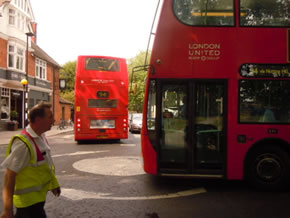Mayor announces new measures to tackle pollution in London
|
Sadiq Khan, the Mayor of London, has announced the formation of 10 new Low Emission Bus Zones including one that will cover Chiswick High Road. These would only allow buses which are less polluting to operate on certain routes with the aim of reducing nitrogen oxide (NOx) emissions.

There are already 2 such zones in Putney and Brixton but the newly revealed ones, which are to be introduced by 2020, include a route between Chiswick High Road and Kensington via Hammersmith Broadway. This would mean that the following routes would all be served by next generation cleaner buses: 27, 237, 267, 391, H91, E3, 190 and 70.
The Mayor's office has clarified earlier confusion as to the extent of the zone. Originally it was feared that the zone would end at Studland Street which is off King Street in Hammersmith. There was speculation that the zone would terminate here to allow older, more polluting buses to operate out of the Stamford Brook Bus Depot. It is now confirmed that the zone would extend the full length of Chiswick High Road.
The Mayor has targeted air quality hotspots where people are exposed to some of the highest levels of nitrogen dioxide (NO2) pollution and where older buses contribute significantly to road transport emissions. The new greener buses, which will be a combination of hybrid and clean buses that meet Euro VI standards, are part of an improvement programme to 3,000 buses outside central London.
The zones are expected to reduce NOx emissions from buses along the routes by around 84 per cent and will fulfil the Mayor’s manifesto commitment to introduce Low Emission Bus Zones by 2020.
The Mayor of London, Sadiq Khan, said: “Tackling London’s filthy air is one of my main priorities and I am delighted to be delivering on that commitment by introducing these new Low Emission Bus Zones. Removing the oldest, dirtiest buses from our streets and delivering Low Emission Bus Zones will make a big contribution to tackling transport pollution.”
He is also urging the Government to introduce a national diesel scrappage scheme.
Other locations of the 12 Low Emission Bus Zones include the Uxbridge Road to Shepherd’s Bush – from Ealing Broadway via Hanger Lane.
The Putney High Street zone will be delivered in March 2017 and the route between Brixton and Streatham is set for October 2017. The zones will utilise a number of ‘Bus Priority Schemes’ that ensure buses have priority over other traffic and are able to keep moving, cutting idling emissions and speed up journey times for passengers. The TfL Business Plan, published at the end of last year, includes a £50m fund to be invested in bus priority schemes, helping attract more people back on to the bus network, and tackling pollution and road congestion.
Councillor Julian Bell, leader of Ealing Council, said: “Air quality is a huge issue for Londoners, which has a real impact on people’s health. I’m sure we’re all sick of putting up with pollution from traffic so I’m delighted that these low emission bus corridors are being extended across the capital, including Uxbridge Road, one of west London's busiest and most polluted routes. I know residents in Ealing, particularly cyclists and pedestrians, will be as pleased as I am to see some real action on this important issue.”
Low Emission Bus Zones are one of a number of measures the Mayor has asked TfL to take to reduce emissions from the capital’s bus fleet, including the phasing out of diesel only buses and a commitment to purchase only hybrid or zero emission double deck buses from 2018.
January 10, 2017